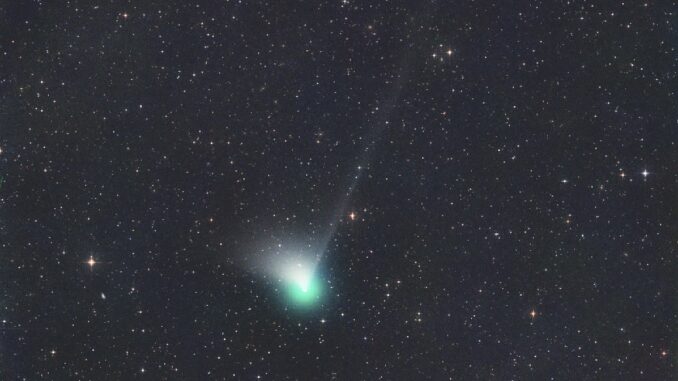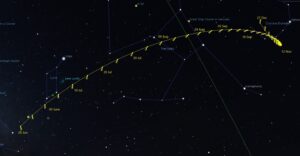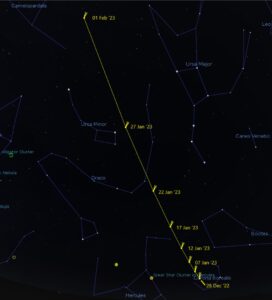
Discovered on 02 March 2022, Comet C/2022 E3 (ZTF) was spotted as a very faint 17.3 magnitude smudge in the constellation of Aquilla. The 1.2m telescope at Zwicky Transient Facility (ZTF) is crowned with the comet’s discovery. Based at the Palomar Observatory in California, this facility is designed to detect transient objects that rapidly change in brightness.
Initial observations identified the object as an asteroid but subsequent observations revealed a very condensed coma. This indicated that the object was in fact a comet.
C/2022 E3 (ZTF) is a long period comet with an estimated orbital period of at least 50,000 years is expected to reach perihelion on 12 January 2023. At this point, the comet will be just over one Earth-to-Sun distance (AU) from the Sun residing in the constellation of Hercules close to the border with Boötes.
E3 will then reach closest approach to the Earth on 01 February 2023.
How bright will Comet C/2022 E3 ZTF get ?
Many have asked “Will C/2022 E3 (ZTF) get as bright as comet NEOWISE in 2020?” The short answer to that is unlikely. However as with all comet brightness predictions, nothing can be ruled out. These balls of ice have a habit of surprising us. E3 (ZTF) could have a sudden outburst (being a relative newcomer to the solar system). Or it could do a Comet ISON and just fizzle out on its journey around the Sun.
The most optimistic predictions say that the comet may reach magnitude +5 at a stretch so it is possible that E3 comes within naked eye brightness. More likely a good binocular object.
Where is comet C/2022 E3 (ZTF) now?
At the time of writing C/2022 E3 is residing in the constellation of Corona Borealis reaching a brightness of magnitude 10. The comet is headed towards Draco and Ursa Minor through January 2023 steadily increasing in brightness along the way.
See the finder charts below to track the comet’s path through 2022 and 2023.
Comet C/2022 E3 (ZTF) Finder Charts


